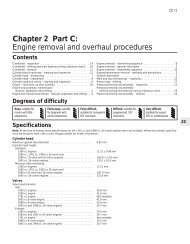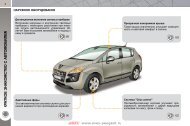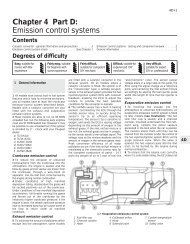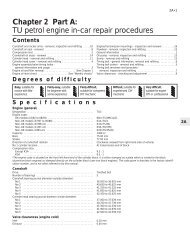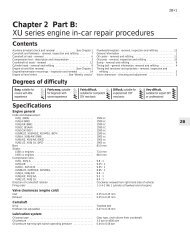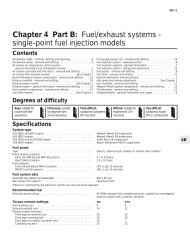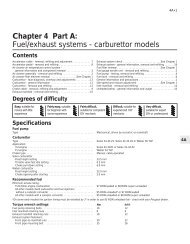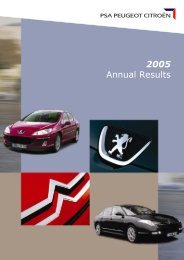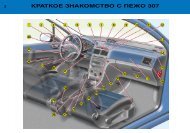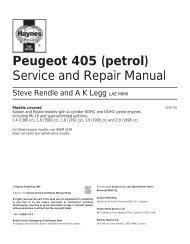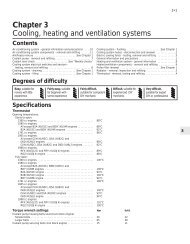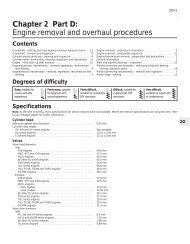Chapter 1 Routine maintenance and servicing
Chapter 1 Routine maintenance and servicing
Chapter 1 Routine maintenance and servicing
You also want an ePaper? Increase the reach of your titles
YUMPU automatically turns print PDFs into web optimized ePapers that Google loves.
1•8 6000 Mile / 6 Month Service<br />
Maintenance procedures<br />
1 Introduction<br />
General information<br />
1 This <strong>Chapter</strong> is designed to help the home<br />
mechanic maintain his/her vehicle for safety,<br />
economy, long life <strong>and</strong> peak performance.<br />
2 The <strong>Chapter</strong> contains a master<br />
<strong>maintenance</strong> schedule, followed by Sections<br />
dealing specifically with each task in the<br />
schedule. Visual checks, adjustments,<br />
component renewal <strong>and</strong> other helpful items<br />
are included. Refer to the accompanying<br />
illustrations of the engine compartment <strong>and</strong><br />
the underside of the vehicle for the locations<br />
of the various components.<br />
3 Servicing your vehicle in accordance with<br />
the mileage/time <strong>maintenance</strong> schedule <strong>and</strong><br />
the following Sections will provide a planned<br />
<strong>maintenance</strong> programme, which should result<br />
in a long <strong>and</strong> reliable service life. This is a<br />
comprehensive plan, so maintaining some<br />
items but not others at the specified service<br />
intervals, will not produce the same results.<br />
4 As you service your vehicle, you will<br />
discover that many of the procedures can -<br />
<strong>and</strong> should - be grouped together, because of<br />
the particular procedure being performed, or<br />
because of the close proximity of two<br />
otherwise-unrelated components to one<br />
another. For example, if the vehicle is raised<br />
for any reason, the exhaust can be inspected<br />
at the same time as the suspension <strong>and</strong><br />
steering components.<br />
5 The first step in this <strong>maintenance</strong><br />
programme is to prepare yourself before the<br />
actual work begins. Read through all the<br />
Sections relevant to the work to be carried<br />
out, then make a list <strong>and</strong> gather together all<br />
the parts <strong>and</strong> tools required. If a problem is<br />
encountered, seek advice from a parts<br />
specialist, or a dealer service department.<br />
2 Intensive <strong>maintenance</strong><br />
1 If, from the time the vehicle is new, the<br />
routine <strong>maintenance</strong> schedule is followed<br />
closely, <strong>and</strong> frequent checks are made of fluid<br />
levels <strong>and</strong> high-wear items, as suggested<br />
throughout this manual, the engine will be<br />
kept in relatively good running condition, <strong>and</strong><br />
the need for additional work will be minimised.<br />
2 It is possible that there will be times when<br />
the engine is running poorly due to the lack of<br />
regular <strong>maintenance</strong>. This is even more likely<br />
if a used vehicle, which has not received<br />
regular <strong>and</strong> frequent <strong>maintenance</strong> checks, is<br />
purchased. In such cases, additional work<br />
may need to be carried out, outside of the<br />
regular <strong>maintenance</strong> intervals.<br />
3 If engine wear is suspected, a compression<br />
test will provide valuable information<br />
regarding the overall performance of the main<br />
internal components. Such a test can be used<br />
as a basis to decide on the extent of the work<br />
to be carried out. If, for example, a<br />
compression test indicates serious internal<br />
engine wear, conventional <strong>maintenance</strong> as<br />
described in this <strong>Chapter</strong> will not greatly<br />
improve the performance of the engine, <strong>and</strong><br />
may prove a waste of time <strong>and</strong> money, unless<br />
extensive overhaul work is carried out first.<br />
4 The following series of operations are those<br />
most often required to improve the<br />
performance of a generally poor-running<br />
engine:<br />
Primary operations<br />
a) Clean, inspect <strong>and</strong> test the battery (see<br />
“Weekly checks”).<br />
b) Check all the engine-related fluids (see<br />
“Weekly checks”).<br />
c) Check the condition <strong>and</strong> tension of the<br />
auxiliary drivebelt (Section 5).<br />
d) Renew the spark plugs (Section 11).<br />
e) Inspect the distributor cap <strong>and</strong> HT leads -<br />
as applicable (Section 22).<br />
f) Check the condition of the air cleaner<br />
filter element, <strong>and</strong> renew if necessary<br />
(Section 21).<br />
g) Renew the fuel filter (Section 8).<br />
h) Check the condition of all hoses, <strong>and</strong><br />
check for fluid leaks (Section 6).<br />
i) Check the idle speed <strong>and</strong> mixture settings<br />
- as applicable (Section 10).<br />
5 If the above operations do not prove fully<br />
effective, carry out the following secondary<br />
operations:<br />
Secondary operations<br />
a) Check the charging system (<strong>Chapter</strong> 5A).<br />
b) Check the ignition system (<strong>Chapter</strong> 5B).<br />
c) Check the fuel system (<strong>Chapter</strong> 4).<br />
d) Renew the distributor cap <strong>and</strong> rotor arm -<br />
as applicable (<strong>Chapter</strong> 5B).<br />
e) Renew the ignition HT leads - as<br />
applicable (Section 22).<br />
6000 Mile / 6 Month Service<br />
3 Engine oil <strong>and</strong> filter renewal<br />
1<br />
Note: On models from 1994, the maker’s<br />
specified interval for this procedure is<br />
9000 miles (15 000 km) or 12 months.<br />
Note: A suitable square-section wrench may<br />
be required to undo the sump drain plug on<br />
some models. These wrenches cab be<br />
obtained from most motor factors or your<br />
Peugeot dealer.<br />
1 Frequent oil <strong>and</strong> filter changes are the most<br />
important preventative <strong>maintenance</strong><br />
procedures which can be undertaken by the<br />
DIY owner. As engine oil ages, it becomes<br />
diluted <strong>and</strong> contaminated, which leads to<br />
premature engine wear.<br />
2 Before starting this procedure, gather<br />
together all the necessary tools <strong>and</strong> materials.<br />
Also make sure that you have plenty of clean<br />
rags <strong>and</strong> newspapers h<strong>and</strong>y, to mop up any<br />
spills. Ideally, the engine oil should be warm,<br />
as it will drain better, <strong>and</strong> more built-up<br />
sludge will be removed with it. Take care,<br />
however, not to touch the exhaust or any<br />
other hot parts of the engine when working<br />
under the vehicle. To avoid any possibility of<br />
scalding, <strong>and</strong> to protect yourself from<br />
possible skin irritants <strong>and</strong> other harmful<br />
contaminants in used engine oils, it is<br />
advisable to wear gloves when carrying out<br />
this work. Access to the underside of the<br />
vehicle will be greatly improved if it can be<br />
raised on a lift, driven onto ramps, or jacked<br />
up <strong>and</strong> supported on axle st<strong>and</strong>s (see<br />
“Jacking <strong>and</strong> Vehicle Support”). Whichever<br />
method is chosen, make sure that the vehicle<br />
remains level, or if it is at an angle, so that the<br />
drain plug is at the lowest point. Where<br />
necessary remove the splash guard from<br />
under the engine.<br />
3 Slacken the drain plug about half a turn; on<br />
some models, a square-section wrench may<br />
be needed to slacken the plug (see<br />
illustration). Position the draining container<br />
under the drain plug, then remove the plug<br />
completely. If possible, try to keep the plug<br />
3.3 Slackening the sump drain plug with a<br />
square-section wrench



